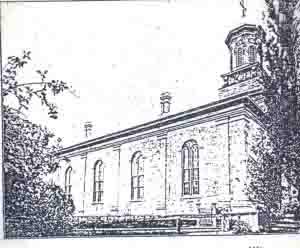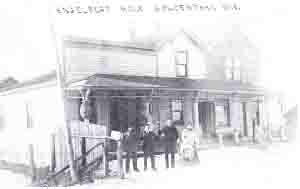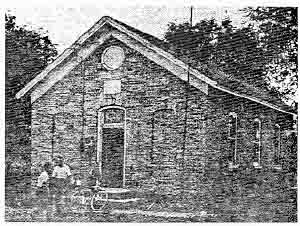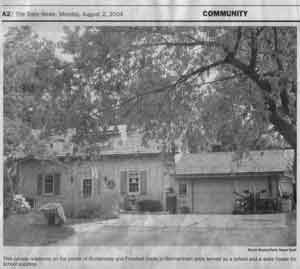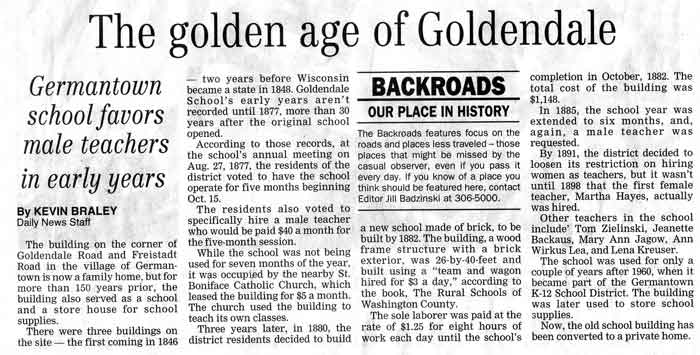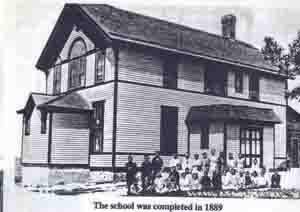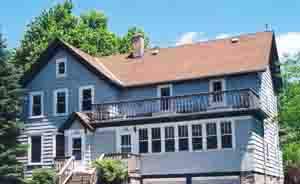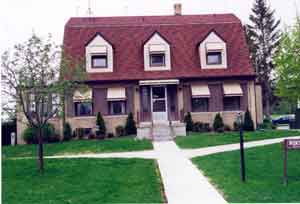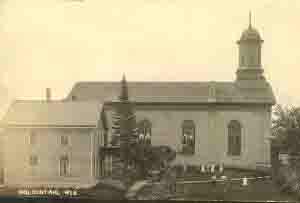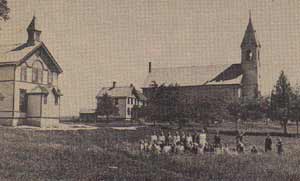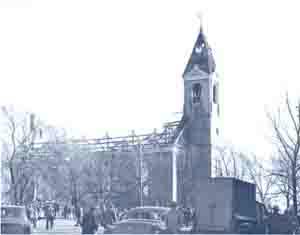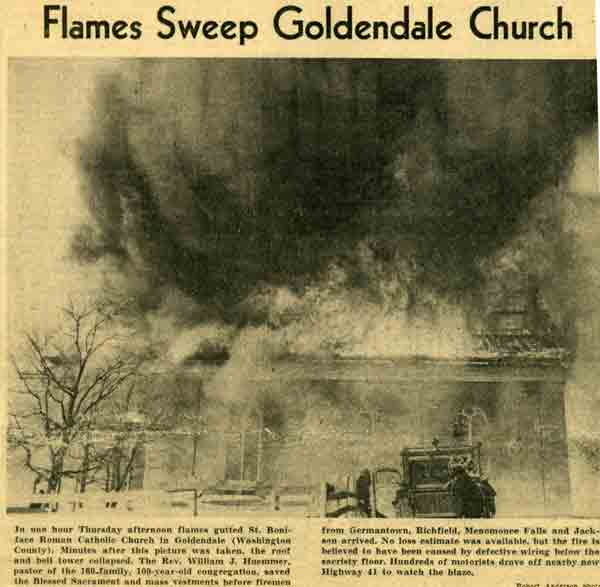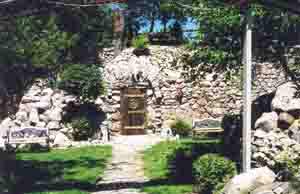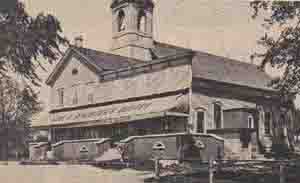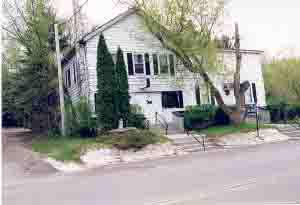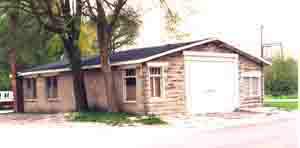|
The community of Goldenthal was located at the intersection of Friestadt and Goldendale Roads. Specifically the SE quarter of section 18, SW quarter of section 17, the NE quarter of section 19 and the NW quarter of section 20. Land patentees: 17/SW - John Mehl; John Merkel 18/SE - Everhardt Holzmann, John Schmitt; 19/NE - John Mehl; and, 20/NW - Johannes Knetzger. In 1859 ownership was shown to: 17/SW - J. G. Mehl; 18/SE - J. Hartman, J. Zellner; 19/NE - J. Mehl; 20/NW - G. Regenfuss. In 1873 ownership was shown to: 17/SW - G. Mehl; 18/SE - G. Spaerl, J. Zoelner; 19/NE - J. Zoelner; 20/NW - St. Boniface, G. Regenfuss In 1873, Goldenthal was a bit unusual, maybe better to say contradictory. In this very small community, there existed one church, two saloons, a brewery, and possibly a house or two. One saloon was located on the northwest corner, a second on the southwest corner, the church on the southeast corner and the brewery and store were contiguous to the church property on its south. But, back to the beginning. Johannes Knetzger and his wife Katherine Hoffman preceded other members of the family and acquired 600 acres the land in sections 17 and 20. This land was later distributed to other family members as they arrived. First purchases were made on 2 August 1842 for land in Section 8/17 and later purchases on 12 September 1842 and 4 November 1843 for land in section 20. The land where St. Boniface now resides was purchased on 4 November. George Regenfuss and his wife Eva Margaretha Knetzger, sister of Johannes, came to own most of the Knetzger land in section 20. George, being a brewer in the old country, started a brewery in Goldenthal in the northwest quarter of section 20. (a picture of the building can be found on page 57 in the book, Germantown: The Early Years 1838-1915. Along with the brewery and to its west along the road was located a store and hotel. Within the brewery was located an underground caves used to store the brew and in later times produce for the hotel. The Brewery's cement/stone foundation walls and its storage cave exists today. This Regenfuss property predates the present St. Boniface Parish location by several years. St. Boniface Parish began in 1845 when a log cabin church building was erected on the then southwest corner of Johannes Knetzger property in section 17. Johannes officially donated this land of 525 feet running east-west and 165 feet running north-south to the Milwaukee Diocese in 1847. This is also where the first parish cemetery was located. The first missionary priest, in 1844, was Reverend Michael Heiss while the first pastor in 1846 was Reverend Francis Xavier Obermüller. About 1847 the parish was relocated to the northwest corner of section 20 on land then owned by George and Eva Margaret Regenfuss. A detailed history of the parish can be found here. In 1847-1848 St. Boniface under Reverend Joseph Salzmann replaced the log church building in section 17 with a wood frame one in section 20. In 1853 Father Francis Xavier Paulhuber replaced the wood frame church building with a larger brick building. About 1868 the community saw the parish replaced their brick church building with a larger edifice built of quarried stone.
St. Boniface Church; Built 1860s: In December of 1865 the Sisters of St. Francis of Assisi arrived at the parish to teach school. The first year Sister Agnes Fleckenstein taught at the district school quite some distance from the church property. Suspect the school was located at Bonniwell and Goldendale Roads. Others believe the school existed closer to the Goldendale/Holy Hill road intersection. For the next three years the sisters taught school in buildings located on the church property. The sisters departed the area in 1869. It was during this time the building shown on the right was being constructed. Construction of this church building was completed in 1868. As mentioned earlier, by 1873 per a plat map of the area, there was a saloon located on both the northwest and southwest corners of the now Goldendale/Freistadt intersection. What is unusual about this is that the same person owned the surrounding property to these saloons but probably not both saloons. You can also suspect that there was a beer dispensing area in the hotel. You begin to wonder where all the patrons came from or maybe the beer was that good. Additionally confusing, the southwest corner property where the saloon supposedly resided had been owned by The Milwaukee Diocese and deeded in 1875 to the school district. So in 1873, St. Boniface was the owner of the land on which a saloon was identified as existing. Possibly this saloon was located a bit further south like maybe 1/2 acre.
As rememberd by Donald Joseph Schulteis in 2008 "My recollection of the Gebhard Saloon and Dance Hall building. The building was situated on the west side of Goldendale Road directly across the street from St. Boniface Parish midway between the new brick school and the church; more towards the school side. It was a frame wooden building. The wood looked grayish as wood gets being exposed to the elements for years and years without paint. At the time, I was a small boy attending St. Boniface Grade School in third or fourth grade. This would be 1948-1949. Walking up to the building, it was shaped as an "L" with the protruding porting of the building on your right. The front porch, believe without overhead, was six or so feet deep and ran from the right protruding building's edge all the way to the left side of the building. For a small boy, the first step up to the porch landing was extra steep. The front door, on the east side of the building, at the time was open so I cannot describe it. I have little recollection of the inside of the room other than it was wider than deep. The picture in my mind had a long counter situated in front of the west wall. Believe to get behind the counter you had to come in from its left side (south) but this is just a recollection/feeling I have today. What it actually was like in 1948-1949 I do not remember. Never was in the dance hall part or the living quarters. I am guessing the dance hall was behind the saloon room and entrance to it was probably from the left of the counter probably in the form of an archway. Assume the living quarters were in the protruding right side of the building. The right side (north) portion of the building may have been two stories. It wasn't many years after that the building burned to the ground. This experience is from the one and only time I was ever inside the building"
The year 1882 saw the school district build a field stone and cement school house on the southwest corner of the now Goldendale and Freistadt Roads. In 2004, this building is used as a family residence.
In 1889 St. Boniface completed the building of their first wood frame two story school building. Sometime after the first world war the community of Goldenthal had its name change to Goldendale. The 1929 plat map continued to show Goldenthal.
In 1931 the St. Boniface parsonage was replaced and the old building was moved to Creek View Lane where it is an area home.
In the spring of 1950 the Gebhard Saloon and Dance Hall was destroyed by fire. A few years later on Thursday, 4 March 1954 the same calamity struck St. Boniface Church as this edifice was consumed by fire. The church building was replaced a little over a year later.
The Regenfuss brewery, located behind (east) of the hotel, has since disappeared with the exception of its foundation and one storage cave. A picture of the brewery, taken in 1910, can be found in the book
As remembered by Arlene (Roskopf) Frey in 2003: "At one time, I lived across the street from George H. Schuster Buffet. It was owned in the early forties by George Schuster and Apolonia "Abbie", his wife, had a little grocery business now where the bar is. The big dark back bar with mirrors is gone, was in what now is a card and dining room for fish fries. The bar room I remember had a pickle barrel and a vinegar barrel, etc."
In 1946 Edward and Florence Wing took ownership of the original Regenfuss hotel establishment then called the George Schuster Buffet. Florence was instrumental in changing the name to the Lone Star Tavern. Florence identifies the building was originally a half way house for travelers going from Milwaukee to West Bend. There were six rooms in the building. Years before a stable was located west across the street. The original building was expanded with considerable difficulty as the interior walls are the original logs. The establishment is now [2003] a tavern and restaurant specializing in fish fries on Friday nights: lake perch, walleye, baked cod, and chicken entires are available. Sheepshead sessions can be found there every Tuesday and Thursday.
Just to the south of the Lone Star was a building used in the mid 20th century as a maintenance facility for the roads. What it was originally built was for, who built it, and when it was built has not been identified. There were a few residences built in the immediate vicinity. That was yesterday. Today the area is rapidly changing into subdivisions. There seems to be a bit of confusion regarding the first Goldendale district school, not that there was one, but where it was located. All know that in 1882 a field stone school house was built on the southwest corner of Goldendale and Freistadt Roads. This building exists today in 2002 as a family home. But, where was the "Goldendale" school before this? Known facts: From this what can we deduce? It is reported that there was a school on the southwest corner of Goldendale and Freistadt Roads in 1846. The source of this information is unknown. In 1846, John Mehl owned the property. In June of that year, Father Obermueller came to St. Boniface as pastor. At that time the parish was located 1/2 mile east on Freistadt on what then was the Knetzger property and today, up to a couple of month ago [July, 2004], the Kolvenbach property. The evidence of a school in this corner area was in 1847/1848 when a Mr. Boeden was the teacher, and who did so, under the direction of Father Joseph Salzmann the then pastor of St. Boniface. At this point St. Boniface had been moved from the Knetzger property to where it is today. So in 1847/1848 we do have a school in that area. Could there have been a "school" building on the SW corner? It is more likely that school was held in the newly constructed wood frame church building erected under the direction of Father Salzmann in the southeast corner. In December 1865 religious teachers (3) came to St. Boniface from Nojoshing (St. Frances -South Milwaukee). In 1866 the Sisters taught at a district school located quite some distance from the parish. Suspect this might have been two miles north on Goldendale Road on Bonniwell. Others believe it was located closer to Holy Hill Road. In 1867-1869 the sister taught school on the parish property. Attendance was over 100 students and it was the then "district" school. The sisters left for La Crosse in 1869 and the St. Boniface "district" school dissolved. It would seem the 1846 "district" school at the corner of Goldendale and Freistadt Roads to be nonexistent unless someone can obtain evidence that this was the case. We know there was a district school prior to 1865 but it was quite some distance from St. Boniface, most definitely not across the street. The 1874 plat map shows it to be located on Goldendale and Bonniwell and that goes along with the Sisters traveling "quite some distance" to get to the school. In 1847 the area where the Goldendale public school was located was given to the Milwaukee Diocese and remained in the diocese hands until 1875 when it was deeded to the school district. So, from what can be determine, there would be no district school on the southwest corner of Goldendale and Freistadt Roads until some time after 1874. In the 1847/48 time frame, there was a school on the SE corner and suspect it may have been a "district" school as it would have been the only school in the immediate area. It would seem that after the Goldendale/Freistadt 1882 school was built, the Goldendale/Bonniwell school building #8 may have been unused until 1901 when it was replaced and became the Oak Grove School. Contradictory evidence, the 1892 plat map has school #8 existing there, which it physically did, but was it in use? Why would you have three schools within two miles of one another and in 1930 one of these schools had but six students? Would suspect in 1901 the attendance figures for a least two of these schools was not much higher. The answer, no answer. |
